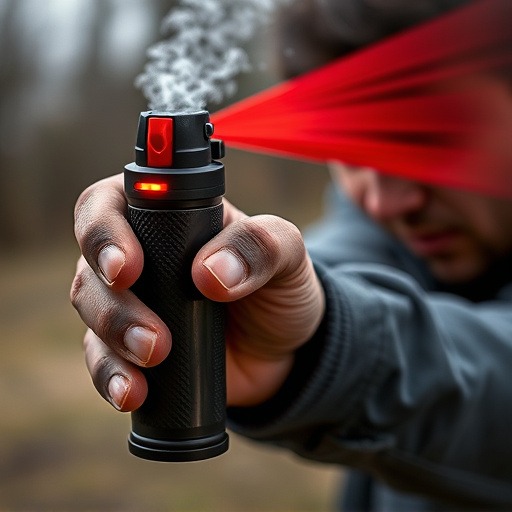Proper maintenance and storage of pepper spray are crucial for ensuring its effectiveness. With a typical shelf life of 2–5 years, regular expiration date checks prevent degradation from environmental factors. Balancing self-defense needs with legal regulations requires adherence to manufacturer instructions, proper training, and using pepper spray as a last resort.
Tactical inflammatory spray, a powerful personal defense tool, has evolved beyond its traditional law enforcement and self-defense applications. This article delves into the crucial aspects of tactical pepper spray defense systems. We explore composition and effectiveness, emphasizing the significance of expiration date checks for optimal performance. Additionally, we cover best practices for maintenance and storage, along with legal considerations and responsible use guidelines to ensure safety and legality.
- Understanding Pepper Spray: Its Composition and Effectiveness
- The Role of Expiration Dates: Ensuring Optimal Performance
- Effective Maintenance and Storage for Longevity
- Legal Considerations and Responsible Use Guidelines
Understanding Pepper Spray: Its Composition and Effectiveness
Pepper spray, a tactical defensive tool, is a potent substance designed to incapacitate an assailant temporarily. Its primary active ingredient is capsaicin, the same compound that gives chili peppers their heat and sting. This chemical irritates the eyes, nose, and respiratory system, leading to temporary blindness, coughing, and difficulty breathing. The spray’s effectiveness lies in its ability to disrupt an attacker’s balance and coordination, providing users with a crucial escape or de-escalation opportunity.
When considering the efficacy of pepper spray, it’s essential to be mindful of its expiration date. Unlike food items, pepper spray doesn’t have a ‘best before’ date; instead, manufacturers provide an expiry period based on testing conditions. Regular maintenance and proper storage are key to preserving its potency. Users should check for signs of deterioration, such as changes in color or consistency, and ensure the nozzle isn’t blocked. A simple expiration date check can make a significant difference in real-world scenarios, ensuring individuals relying on this self-defense mechanism have access to a reliable and effective product when needed most.
The Role of Expiration Dates: Ensuring Optimal Performance
The effectiveness of a tactical inflammatory spray defense system heavily relies on regular maintenance and awareness of expiration dates. Unlike traditional consumer products, pepper spray is designed for critical self-defense situations, making it crucial to understand its shelf life. Manufacturer guidelines clearly state that pepper spray has a limited lifespan, typically around 2–5 years, after which its potency decreases significantly. This means that proper storage conditions are essential; extreme temperatures, direct sunlight, and moisture can all accelerate the degradation process.
Regularly checking the expiration date on your pepper spray is an integral part of being prepared for emergencies. Past the expiration mark, the active ingredients may lose their power, reducing the spray’s impact during a confrontation. To ensure optimal performance when it matters most, users should treat expiration dates as strict deadlines. Regularly replacing outdated spray canisters ensures that you’re equipped with a reliable defense mechanism, providing peace of mind and enhanced personal safety.
Effective Maintenance and Storage for Longevity
Proper maintenance and storage are essential to ensure the longevity of your tactical inflammatory spray defense system. Regularly inspect the spray can for any signs of damage, corrosion, or leakage. Keep it in a cool, dry place away from direct sunlight and extreme temperatures, as these conditions can affect the spray’s performance and reduce its effective lifespan.
Remember to check the pepper spray expiration date regularly. Unlike food items, pepper spray does not have an obvious ‘best before’ label, so users often overlook its shelf life. However, over time, the active ingredients in the spray can degrade, reducing its potency. It’s crucial to dispose of expired or near-expired units and replace them with fresh ones to maintain optimal defense capabilities.
Legal Considerations and Responsible Use Guidelines
The tactical inflammatory spray, often referred to as pepper spray, is a powerful tool for self-defense and law enforcement purposes. However, its use comes with significant legal considerations. Each jurisdiction has specific laws governing the possession, carrying, and deployment of pepper spray. It’s crucial to understand these regulations to ensure compliance and responsible use. One critical aspect is checking the expiration date of the spray, as most have limited shelf lives. Regularly inspecting the product’s freshness is essential for its effectiveness and legal defensibility in case of misuse allegations.
Responsible use guidelines are also vital to promote safety. This includes proper training for individuals deploying the spray, ensuring it’s only used as a last resort when facing imminent physical harm, and adhering to manufacturer instructions. Law enforcement agencies and private citizens alike must balance the need for self-defense with the potential consequences of using pepper spray, especially in crowded public spaces or against vulnerable populations.
A tactical inflammatory spray defense system, such as pepper spray, is a powerful tool for personal safety. To ensure its effectiveness, regular maintenance, proper storage, and checking expiration dates are paramount. By understanding the composition, legal considerations, and responsible use guidelines, individuals can make informed decisions to protect themselves. A simple Pepper Spray Expiration Date Check can prevent an ineffective or even harmful response in critical situations, making it a crucial step for anyone considering self-defense options.
